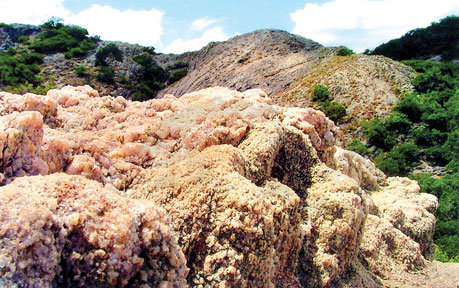Namal Uyana, a sanctuary for birds and animals
by Namal Rajapaksa MP
Situated in the approximate centre of our country, the town of
Dambulla contains a rich heritage of historic value. Just 15 km away
from the Dambulla town, upon arrival at a two-way junction one is
presented with a vast acreage of thick wooded jungle of green and
encompasses an area of approximately 2,000 acres.
 |
|
Ven Wanawasi Rahula
Thera |
Going through Dambulla and heading towards Jaffna on the A-9 highway
and on branching off at Madatugama junction and going towards
Aadiyagala, one gets on the Galewela - Dambulla highway 91. At the
junction, turning towards Ibbankatuwa tank in the outskirts through
Komaliya towards Galkiriyagama, and Pubbogama, from there towards
Aadiyagala, after a distance of 2 km, one gets closer to the dense
jungles.
Turning off at Galewala, through Kalaruwa on the Kekirawa and turning
off at Aadiyagala is a closer route to get to the jungle.
Situated in the Anuradhapura district in the Palagala Divisional
Secretariat and the Galkiriyagama Police division, sits a beautiful
little village named Ulpathgama, which has great historic significance
but its importance was not made aware since its close proximity to the
scenic greenery of the vast forest area surrounding it. However, those
aware of the value of this forest made use of it for the disreputable
activities of the illegal feeling of these valuable trees. Some rob the
ancient treasures found in caves and in the process, these thieves who
have no heart or conscience kill innocent human beings.
When approached from any road, one comes across the famous area of
“Namal Uyana”, Asia's largest location containing Rose Quartz. Having a
mixture of dry zone and wet zone climates, a visit to this area will
envisage an unforgettable never-before-experienced adventure to please
the eyes, calm the mind and body. The experience cannot be described in
words but must be seen to believe.
Pink quartz
It is said in folklore that the pink quartz contained in “Namal
Uyana” was taken to India to decorate and beautify the famous Taj Mahal.
This valuable stone is present in approximately 600 acres in this forest
and interestingly there is no presence of any common black rock in the
entire area which goes to show the natural value of the area and is
worth taking note of for posterity.
The known area of Namal Uyana is approximately 2,000 acres and within
these boundaries contain national treasures of great value in the form
of artefacts and statues is an indication of the beauty of this
strategic forest in the years gone by and is worth nurturing for the
future generations to come.
Ranavaya is the village situated in the East of Namal Uyana. Sri
Lanka's historic event of great Dutugemunu Elara war named “Vijithapura
battle” took place in this location and is recorded in the books of
history. King Dutugemunu having defeated King Elara in this great battle
was able to rule in this region. From Vijithapura to the village of
Ranava is roughly 15 kilometres. It is reported that the villagers of
Ranava made weapons and took to the battlefield and joined forces with
the King's soldiers to support King Dutugemunu in this great battle. The
famous ‘Aadiaagala letters” written by King Dappula the fifth is found
in front of the ‘Devrada Randaru’ temple in Ranava.
The ‘Aadiyaagala Letters’ contain details of how the King had no
power to capture a traitor who entered this village. Namal Uyana which
is surrounded by the villages named Morothegama, Ulpathagama,
Narangaswewa, Ranava and Dambulluhalmallawewa is not only a sanctuary
for birds and animals, but also a place of mental and physical
relaxation and meditation for people of all walks of life and is the
only such location containing its unique features in the island.
I visited Namal Uyana with the intention of ascertaining the
historical significance of this area and wish to inform and educate
readers in this historic exercise.
Upon entrance to Namal Uyana, one is privy to a spectacle of Na trees
which is a sight to behold.
Na tree
It is said that the famous Ven Mangala-Sumana-Revatha and Venerable
Sobitha Theras received enlightenment under the Na tree. Hence, the Na
trees have great significance in Buddhist history and worship. History
has handed down this reverence for the Na tree to such an extent that
when one enters Namal Uyana, travellers have a heightened sense of
reverence from deep within leading to a meditative experience.
The fragrance emanating from the Na flowers bring forth a sense of
serenity of both mind and body. It also brings to mind the true value of
nature and in being one with the environment.
Hence Namal Uyana is Sri Lanka's largest Na tree forest covering
approximately 200 acres which is a vista of flowering trees as far as
the eye could see. Due to the sheer beauty of this spectacle, the
Government through a Gazette notification on April 26, 2005 has declared
this sanctuary a protected forest area.
When trekking through the forest, there is a huge “Moragaha” which is
reported to have been a contributory factor to the adding to beauty of
the Na trees. Namal Uyana was made famous through Ven. ure's ecological
balance.
The true spirit of Buddhism is portrayed through this simple example
of a tree which unlike man has no enemy and harbours no grudge or takes
revenge but instead protects, feeds and shelters both man and beast and
is a vital truth enhancing the value of Buddhist teaching.
It is indeed a wonder when one meditates on the fact of how Wanawasi
Rahula Thera who is reported to have received shelter under this
Moragaha. He was protected by wild animals and vicious snakes by this
tree.
 |
|
Rose Quartz rocks |
Although man is destroying nature and plundering the forests by the
felling of trees etc. the trees in return only provide shelter and
protection to both man and beast and help preserve natthis Ven. Thera
lived amidst the dangers and discomfort of a forest in solitary status
and yet found peace and contentment amidst the trees, especially living
perched on the high branches of the Moragaha.
Historic artefacts
It is a deep seated fact that a true Buddhist knows no fear and is
one with nature so that no harm comes to those who do not wish harm to
others.“In the same way we preserve and protect the environment we live
in, it will in return protect and nurture us. Therefore, I love them
like my own children”, said the Ven. Wanawasi Rahula Thera.
In the sites containing historic artefacts and statues it is reported
that they have been places of religious worship estimated to be during 8
AD.
What we witness today of the sheer beauty, religious and historic
significance of Namal Uyana and is portrayed was initially made famous
by this bhikkhu. One cannot talk about Namal Uyana without talking of
the Ven. Rahula Thera. The true beauty of Namal Uyana and the valuable
Rose Quartz is closely linked with an unbreakable bond with this humble
bhikkhu.
This 2,000 acre Na tree forest has received world acclaim for its
beauty and cultural heritage and has been declared a heritage site has
been promoted and nurtured to the public largely due to the untiring
efforts of this Ven. bhikkhu who practically single-handedly looked
after this Na forest for 22 fruitful years. Ven. Rahula Thera achieved
the goal of turning Namal Uyana into a renowned site of religious
significance through the inspiration of a dream he had.
This dream became a reality and today is a national treasure and
world renowned heritage site.
“The destroying of both trees and wild life is the beginning of the
end for mankind. To prevent this from happening, it is vital to nurture
and preserve this treasure for the generation to come!
The writer is Chairman, National Namal Uyana Development Trust |



